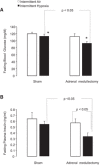Effect of adrenal medullectomy on metabolic responses to chronic intermittent hypoxia in the frequently sampled intravenous glucose tolerance test
- PMID: 28104753
- PMCID: PMC5407201
- DOI: 10.1152/japplphysiol.00975.2016
Effect of adrenal medullectomy on metabolic responses to chronic intermittent hypoxia in the frequently sampled intravenous glucose tolerance test
Abstract
Obstructive sleep apnea is associated with type 2 diabetes. We have previously developed a mouse model of intermittent hypoxia (IH) mimicking oxyhemoglobin desaturations in patients with sleep apnea and have shown that IH increases fasting glucose, hepatic glucose output, and plasma catecholamines. We hypothesize that adrenal medulla modulates glucose responses to IH and that such responses can be prevented by adrenal medullectomy. We performed adrenal medullectomy or sham surgery in lean C57BL/6J mice, which were exposed to IH or intermittent air (control) for 4 wk followed by the frequently sampled intravenous glucose tolerance test (FSIVGTT) in unanesthetized unrestrained animals. IH was administered during the 12-h light phase (9 AM to 9 PM) by decreasing inspired oxygen from 21 to 6.5% 60 cycles/h. Insulin sensitivity (SI), insulin independent glucose disposal [glucose effectiveness (SG)], and the insulin response to glucose (AIRG) were determined using the minimal model method. In contrast to our previous data obtained in restrained mice, IH did not affect fasting blood glucose and plasma insulin levels in sham-operated mice. IH significantly decreased SG but did not affect SI and AIRG Adrenal medullectomy decreased fasting blood glucose and plasma insulin levels and increased glycogen synthesis in the liver in hypoxic mice but did not have a significant effect on the FSIVGTT metrics. We conclude that, in the absence of restraints, IH has no effect on glucose metabolism in lean mice with exception of decreased SG, whereas adrenal medullectomy decreases fasting glucose and insulin levels in the IH environment.NEW & NOTEWORTHY To our knowledge, this is the first study examining the role of adrenal catecholamines in glucose metabolism during intermittent hypoxia (IH) in unanesthetized unrestrained C57BL/6J mice. We report that IH did not affect fasting glucose and insulin levels nor insulin sensitivity and insulin secretion during, whereas glucose effectiveness was decreased. Adrenal medullectomy decreased fasting blood glucose and insulin levels in mice exposed to IH but had no effect on glucose metabolism, insulin secretion, and insulin sensitivity.
Keywords: glucose effectiveness; insulin resistance; obstructive sleep apnea; type 2 diabetes.
Copyright © 2017 the American Physiological Society.
Figures






References
-
- Alonso LC, Watanabe Y, Stefanovski D, Lee EJ, Singamsetty S, Romano LC, Zou B, Garcia-Ocaña A, Bergman RN, O’Donnell CP. Simultaneous measurement of insulin sensitivity, insulin secretion, and the disposition index in conscious unhandled mice. Obesity (Silver Spring) 20: 1403–1412, 2012. doi:10.1038/oby.2012.36. - DOI - PMC - PubMed
MeSH terms
Substances
Grants and funding
LinkOut - more resources
Full Text Sources
Other Literature Sources
Medical

